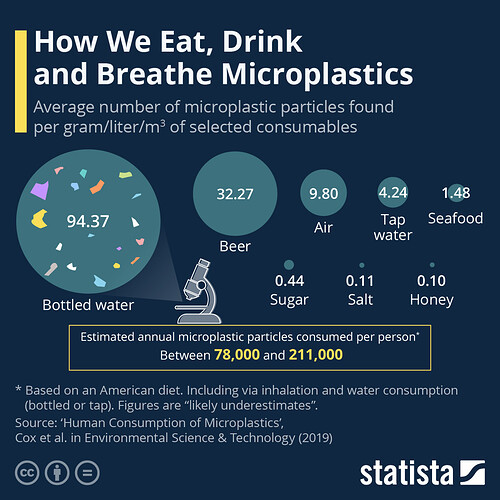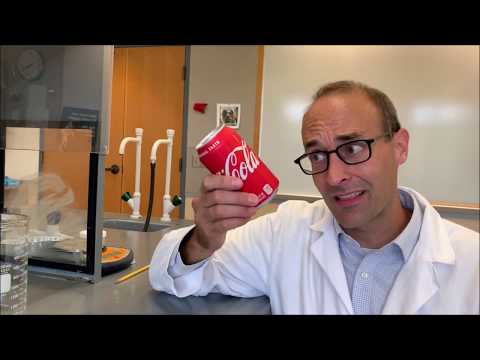and i thought they were better than plastic
Irregular shape was the only MP characteristic predicting cell death.
Apples (M. domestica). As much as 195,500 micro- and nano-plastic particles were found.
Pears (P. communis). 189,550 micro- and nano-plastics were found.
Broccoli (B. oleracea italica). 126,150 micro- and nano-plastic particles were found.
Lettuce (L. sativa). 50,550 micro- and nano-plastic particles were found.
Carrots (D. carota). 101,950 micro- and nano-plastic particles were found.
…per…gram?
We can hypothesize that the fruits contain more MPs not only because of the very high vascularization of the fruit pulp but also due to the greater size and complexity of the root system and age of the tree (several years) compared to the vegetables (60–75 days for the carrot). Also, the carrot has small, microscopic hairs on the outside of the epidermis of central root and these serve to increase the surface area of the root but survive for only a few days. The moisture content of carrot and apple are similar, from 86 to 89% (Sharma et al., 2012) for carrot and 84–86% for apple (Canet, 1988).
===
and in meat too?!?
Microplastic Contamination of Chicken Meat and Fish … - MDPI
https://www.mdpi.com › pdf
](https://www.mdpi.com/1660-4601/19/20/13442/pdf)
by RZ Habib · 2022 · Cited by 1 — Abstract: Microplastic contamination was found in fish and chicken bought on the market, in food stores and in chain supermarkets in the Middle …
[the units between the studies above used are different - thus impossible to compare between animals and plants, but it MIGHT be possible that the membrane of one is more permeable to them than the membrane of the other]
====
===
(in this case, appetite suppression + air purifiers may be the most robust way to reduce microplastic consumption, damnit). Chewing 2mg of nicotine gum when hungry helps annihilate the appetite (also, DRINK coffee and tea - while coffeemakers may have hot water touch plastic, coffee also excellently suppresses appetite). This may be an argument to eat more calorie-dense foods like nuts.
[important to compare # of particles of air pollution that one inhales in a day [at the WHO limit of 10 ug/m^3] vs # of microplastics one ingests in a day]. Particles of air pollution are not the same as microplastics, but there is a way to compare counts to estimate if [over the past few decades] reductions in air pollution are higher or lower than increases in microplastics
https://www.aljazeera.com › gallery › 2020/12/11 › in-…
Dec 11, 2020 — And over a lifetime, we consume about 20kg (44 lb) of microplastic. Pieces of plastic straws weighing 0.7g, the equivalent of the amount of …
[
How much plastic do you eat? It could be as much as a credit …
https://www.euronews.com › green › 2022/04/11 › ho…
](How much plastic do you eat? It could be as much as a credit card a week | Euronews)Apr 11, 2022 — A recent study has found that people eat five grams of micro and nanoplastics every week. From the most remote depths of the ocean, …
(this is the 2019 study, these numbers are underestimates)
posted more here 195,500 particles of plastic **per gram** of apple? 126,150 particles **per gram** of broccoli? - #4 by AlexKChen - Rapamycin Longevity News
Oh… god… 2022 paper from NIST… trillions of nanoplastics per liter of “paper” coffee cup. Everything from before 2020 may be a huge underestimate.
“On a personal level, I have tried to reduce the exposure of foods and water to plastics in my life,” Zangmeister said. “Much of the plumbing in modern society is plastic, water filters are made from polymeric [plastic] materials, so elimination of plastic exposure can be a real challenge.”
==
The digestion method was optimized for eggs to better isolate MPs, which proved MPs indeed exist in eggs, and the average content was 11.67 ± 3.98 particles/egg. The shape and size range of most MPs were spherical and 50–100 μm. The infrared results showed that the main type of MPs in eggs was polyethylene
Shower Curtains
Cheap shower curtains made of polyvinyl chloride (PVC) are notorious for off-gassing hormone-disrupting phthalates and other noxious chemicals for weeks after their installation.[31](javascript:void(0)) PVC-laden shower curtains are made of flexible plastic, sometimes transparent, that has the look and feel of a thick plastic food wrap—plastic food wraps are also often made of PVC. And you can also recognize PVC from its recycling code #3, which may be on the shower curtain label.
The best plastic-free shower curtain alternative we have found is hemp. Although more expensive than its plastic counterpart, a hemp shower curtain is naturally mildew and mold resistant up to a point. You must ensure your bathroom is well ventilated to allow the curtain to dry completely, and you should wash your curtain with vinegar if you do see any mold developing.
on polylactic acid: Do poly(lactic acid) microplastics instigate a threat? A perception for their dynamic towards environmental pollution and toxicity - ScienceDirect
Your citation:
“When fish ingest microplastics, the microplastics, if remaining in the fish,
mostly reside in the stomach/intestines, which, especially in the case of larger fish, will
be cut away, and for the most part will not constitute food for human consumption.” […] “0.03 ± 0.03 MP[microplastic]/g fish”
Basically, select fish fillets may be likely safer from microplastics than select fruits even after washing.
Why This May Be the Future of Plastic Recycling - YouTube => it may be that PET and polycarbonate (and the plastics w/weirder chemical structures) become less bad than polyethylene or polypropylene simply b/c PET is more molecularly distinct and easier to find unique non-promiscuous enzymes that act on them
https://static.ewg.org/reports/2019/pfa-timeline/3M-DuPont-Timeline_sm.pdf
Went through the first 130 pages, and really it is the second page that teflon-pilled me.
It says pfas bind strongly to protein, and was used to precipitate proteins from solution as a standard laboratory practice. Later, a 3M manual to understanding pfas describes surfactants and hydrophobic/philic surface interfaces.
What I gather, is pfas are binding to all the proteins in the body and causing random noise with all protein interactions in the body.
The mouse studies do say, certain amounts of pfas exposure cause liver inflammation. Then later there are a bunch of human cancer correlations.
If PFAS are causing signaling noise and binding interference in biological systems via protein hydrophobic/philic pocket binding, and PFAS accumulate in the body over time, this is an enormous health risk that does not need a proven mechanism to regard as serious. It’s only a question of the scale of effect.
Which, albeit is always the concern with toxic pollutants. As in, what is a person or a society getting out of this vs the cost of pollution?
In the absence of highly inflationary banking I like to imagine that we could clean up and control our pollution like we handle sanitation.
Recycled plastics even worse - Recycled plastic bottles leach more chemicals into drinks, review finds | Plastics | The Guardian
Most of the plastic ever produced (4977 Mt) may be “environmentally available” in 2015 (i.e., in continental or aquatic systems), and this number could reach 12000 Mt by 2050, [(3)](javascript:void(0)
with agricultural soils potentially storing more microplastic than oceanic basins. [(4)](javascript:void(0)
A potentially important source of microplastics to soils is tire wear, but its abundance in relation to other particle types remains to be broadly determined. Notwithstanding, it is reported that microplastics in soils can reach >40000 particles kg–1, with microplastic fibers as the predominant microplastic type (up to ∼92%), followed by fragments (4.1%).
HOW TO SEE MICROPLASTICS: https://vimeo.com/sccwrp/review/329607516/517202d1cd
Measuring Microplastics Workshop - Southern California Coastal Water Research Project
[even the regenerative soil science person -https://www.thepermaculturestudent.com/ - has seen it in soils]
In this study, combined with 137Cs, 210Pb, and spherical carbonaceous particles (SCP) high-resolution chronology, a microplastics-time curve was established by using the sedimentary record from an urban lake in Wuhan city. The microplastic abundance increased from 741 items·kg−1 to 7707 items·kg−1 over the past 60 years
https://www.reddit.com/r/PlasticFreeLiving/
FWIW, British Columbia is progressing towards progressive policies on this issue (their ocean waters are also cleaner of those than most, given that the cold ocean surface there COME FROM unpopulated areas).
Omg contact lenses too…
(this would be an interesting/important test to see if they have detrimental ocular/corneal effects on average [in cells that have massively increased exposure], even if initially very subtle)
===
The research also showed irregularly shaped microplastics caused more cell death than spherical ones. This is important for future studies as many microplastics bought for use in laboratory experiments are spherical, and therefore may not be representative of the particles humans ingest.
“This work helps inform where research should be looking to find real-world effects,” said microplastics researcher Steve Allen. “It was interesting that shape was so important to toxicity, as it confirms what many plastic pollution researchers believed would be happening - that pristine spheres used in lab experiments may not be showing the real-world effects.”
It’s impossible to give quantities, but better to source food from areas/regions that are lower pollution, higher elevation, have lower population densities, and are not grown from deltas downstream from pollution (eg Canada [and especially British Columbia] and Northern Europe are better to source food from). Everything else equal, cold-weather crops (eg Canadian blueberries) tend to come from lower population/less polluted areas [British Columbia and Northern Europe are also unusually warm for their latitude, allowing for SOME things to be grown]]. Southeast Asian countries seem to have especially high plastic [and all] pollution levels
(maybe isolated islands, like Hawaii and Cuba, also have lower soil/microplastic pollution problems, but Hawaii seems to attract a lot of plastic pollution on its islands - https://www.civilbeat.org/2019/12/what-are-the-long-term-impacts-of-microplastic-pollution-in-hawaii/ [unsure how relevant this is for crops grown on the interiorof Hawaii]. Cuba is way more environmentally conscious than other countries that don’t max out on their HDI.
Thanks to support from the Harvard Presidential Scholarship Fund, Legoski was able to come to Harvard Chan School to get the science background he wanted. In a class last fall on analytical methods and exposure assessment, he and a group of fellow students studied the role of compostable beverage containers in microplastic contamination.
Jonathan Buonocore, research scientist at Harvard Chan School, advised Legoski and the other students on their research. “With the issue of plastics, we have been hearing about impacts on sea turtles and pollution on beaches, but Saamon wondered if humans are getting exposed to microplastics through compostable cups,” he said. “He took it upon himself to find a way to address the question.” Previous studies have suggested that microplastics consumption may harm health. The students found significant leaching of microplastics from some of the compostable cups they looked at.
More recently, a study with a lower detection limit of 0.8 µm reported a MP fiber concentration of about 5600 p m-3 at human respiratory height. More than 80% of all detected airborne particles were smaller than 20 µm (Li et al., 2020). Consequently, assuming an average breathing volume of 6 l min-1, humans might be exposed to more than 48,000 MP p d-1 by inhalation. These findings reinforce the concerns about airborne MP contamination raised by earlier studies (Prata, 2018, Vianello et al., 2019). Furthermore, ingestion of airborne MP mainly occurs due to the fallout of atmospheric MP during meal preparation and consumption. Approximately, humans consume 40 – 190 p d-1 in this way (Catarino et al., 2018).
In addition, certain types of microparticles which are often perceived as biodegradable, such as cellulose-based particles like cotton or wood dust (2.4 Wood dust, 2.5 Cotton dust), can be very bio-persistent inside mammalian organisms (Harper et al., 2002, Eriksson et al., 1990
https://www.sciencedirect.com/science/article/pii/S0304389421031216#sec0010
(this is comparison with MICROPARTICLES - eg wood dust/cotton dust, for which humans have been exposed to prior to the microplastic influx).
But might crops absorb plastics in the soil, like they do water and nutrients, and incorporate them in these edible bits? To test this, Wash- ington State University soil scientist Markus Flury and his colleagues at the Pacific Northwest National Laboratory recruited wheat and a com- mon plant used in crop science, thale cress, as botanical guinea pigs. These species represent the two types of root strategies in the plant king- dom: wheat uses a fibrous root system, in which lots of filaments spread
through the soil like a net, while thale cress uses a taproot system, in which smaller offshoots branch off from a thick main root—think of a carrot growing underground. Flury and his team grew seeds from each species in agar—a sort of scientific Jell-O—laced with fluorescent mi- croplastic and nanoplastic beads.102
When Flury looked at the plants under a confocal microscope, which shines lasers that make the fluorescent dye in the plastics glow, he found particles had attached to the roots but hadn’t penetrated them. So this is worrisome in that plastics might be accumulating around the roots we eat—carrots, sweet potatoes, radishes—but it’s good news in that nei- ther a fibrous nor taproot system seemed to uptake plastic into the plant itself, unlike how crops readily soak up nutrients like nitrogen and iron. “The plant has probably an incentive to take up an iron particle, whereas a plastic particle will not be used by the plant,” says Flury.
This contradicts previous lab studies on wheat and other crops, like beans and onions and lettuce, showing that roots do take up plastics.103 Over at ETH Zürich, analytical chemist Denise Mitrano took a differ- ent tack, tagging nanoplastics not with fluorescence but with the rare metal palladium. And instead of growing wheat in agar, she grew it hy- droponically, exposing the growing plants to the “doped” particles. She could then track the nanoplastics as the wheat plants took them up into their roots and shoots. “We didn’t let the wheat go to grains, so we don’t know if the nanoplastic would eventually get into the food source, but it did go up further into the plant,” says Mitrano. However, she didn’t see any big changes in the physiology of the plants, like growth rate or chlo- rophyl production. “But we did see that it changed the root structure a bit and the cellular structure in the root, which would indicate that the plant was still under stress.”
I live in San Francisco, which draws from Yosemite’s Hetch Hetchy Reservoir, a source of water so pure, the state doesn’t require it to be filtered before it comes out of my faucet. “No one has tested San Francisco tap water for microplastics,” Coffin says. “But we believe that of all the places in California that we’re going to find it, we’re going to find it in highest quantities in San Francisco’s, because there’s no filtration at all.”
if you’re drinking treated water, count your blessings. A third of humanity lacks access to a safe supply of drinking water, exposing these people to all kinds of diseases and potentially more microplastic.121 If you’re drawing your water from a plastic-polluted lake or river, you may be drinking a sort of plasticine soup—as bottles and bags float around baking in the sun, they’re jettisoning little bits of themselves. Add to this the runoff from cities, bits of car tires and cigarette butts and fibers from our clothes, and a water source grows lousy with petroparticles. Indeed, a survey of 67 European lakes found the concentrations of microfibers to be four times greater in waters with high human activity than in more remote systems.122 The densely populated Great Lakes are packed with particles: one study found over 12,000 microplastics and other anthropogenic particles in just 212 fish pulled from Lake Ontario— one unlucky animal had 915 pieces in its gut
n 2015, researchers sampled the living rooms of two apartments in Paris, each home to two adults and a child, as well as a university office where three people worked.31 They only sampled air when people were present in the rooms, both at a height of about four feet to gather what the subjects are breathing, and a half inch off the ground to determine the deposition rate of dust. The researchers also took samples from vac- uum cleaner bags the occupants had used in the two apartments.
In one apartment, they counted up to 14 fibers floating in a cubic yard of air, 12 in the other, and 45 in the office. Based on the number of particles they caught near the floor, the researchers calculated that up to a thousand fibers are deposited per square foot each day, which matched with the number of fibers they found in the vacuum bag
[well at least they still don’t make up the majority of PM2.5 pollution, and that is declining, and that reason alone is why I don’t freak out that much yet…]
I’m noticing estimates are on the severely low end… But you also have to ask questions like "total consuption of dirt/wood particles [or rocks] because some of these also get lodged in the body over time and THEN compare this to microplastic dose…
“BPA hardens plastics and phlatates soften them”
In one study, 11 patients in Malaysia who’d undergone colectomies—the removal of portions of the colon—provided tissue samples.100 Nine of the patients had colon cancer and two did not. Researchers sifted through the samples and found an average of 800 microplastics per ounce of tissue. They noted the prevalence of transparent filaments, suggesting the digestive system bleached the particles, an indication that the colorants and other ad- ditives in microplastics leach out in this hot and acidic environment, though this may instead be due to the fact that single-use plastic food wrappers tend to be clear, so the patients could have eaten already-trans- parent microplastics


